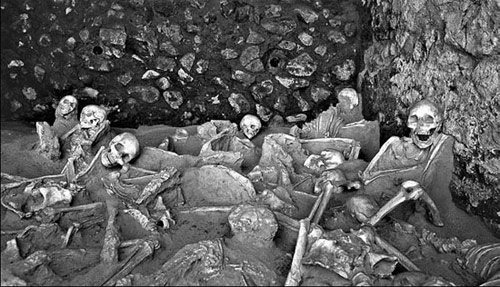
 'Taken 2' grabs movie box office crown
'Taken 2' grabs movie box office crown
 Rihanna's 'Diamonds' tops UK pop chart
Rihanna's 'Diamonds' tops UK pop chart
 Fans get look at vintage Rolling Stones
Fans get look at vintage Rolling Stones
 Celebrities attend Power of Women event
Celebrities attend Power of Women event
 Ang Lee breaks 'every rule' to make unlikely new Life of Pi film
Ang Lee breaks 'every rule' to make unlikely new Life of Pi film
 Rihanna almost thrown out of nightclub
Rihanna almost thrown out of nightclub
 'Dark Knight' wins weekend box office
'Dark Knight' wins weekend box office
 'Total Recall' stars gather in Beverly Hills
'Total Recall' stars gather in Beverly Hills
Vesuvius site is a model for others
Updated: 2012-11-26 16:24
By Elisabetta Povoledo (China Daily/Agencies)
|
||||||||
 |
|
A public-private venture has been successful in preserving a city destroyed in the eruption of Mount Vesuvius. A boathouse where citizens had hoped to be rescued. [Photo/Agencies] |
HERCULANEUM, Italy - They are poignant snapshots of sudden death: huddled clusters of skeletal remains in what were once beachfront warehouses, immortalized for eternity when Mount Vesuvius smothered this ancient Roman town in A.D. 79.
"They died of thermal shock as they were waiting to be saved via the sea," Domenico Camardo, an archaeologist, said recently.
First excavated some 30 years ago, the warehouses were recently outfitted with walkways to provide access to these chilling tableaus and will soon be open to the public on special occasions.
Reviving history for a modern audience "is one of the beautiful things we get to do," said Mr. Camardo, the lead archaeologist with the Herculaneum Conservation Project, a joint initiative of the Packard Humanities Institute, of Los Altos, California; the local artistic heritage authority; and the British School at Rome. The project, a public-private venture, has effectively managed the site for more than a decade.
Compared with its better-known Vesuvian neighbor, Pompeii, where local officials, constrained by inadequate and mismanaged government funds, have long struggled to conserve and protect the sprawling open-air site, Herculaneum has become a textbook case of successful archaeological conservation.
The "invisible work" at Herculaneum focuses on structural elements. A tunnel under the city.
Most Viewed
Editor's Picks

|

|

|

|

|

|
Today's Top News
Health new priority for quake zone
Xi meets US top military officer
Japan's boats driven out of Diaoyu
China mulls online shopping legislation
Bird flu death toll rises to 22
Putin appoints new ambassador to China
Japanese ships blocked from Diaoyu Islands
Inspired by Guan, more Chinese pick up golf
US Weekly

|

|







